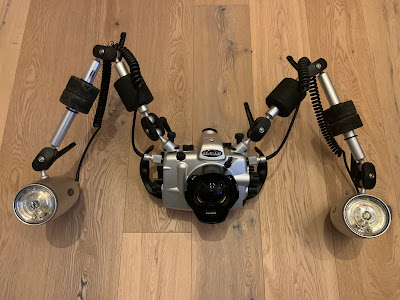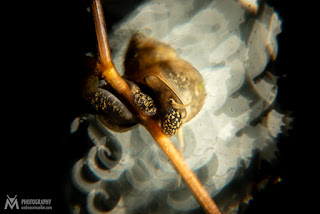- Batteries Charged: Ensure all camera, strobe, and dive computer batteries are fully charged.
- Memory Cards: Verify you have sufficient space (and spares) on your memory cards.
Pre-Dive
- Assemble and Seal the Housing
- Securely mount the camera in the housing.
- Check O-ring cleanliness and lubrication before closing.
- Perform a quick test shot to confirm autofocus and strobe triggering.
- Attach the port/lens cover to protect the glass until entry.
- Dive Computer Placement
- Some photographers attach the dive computer to a strobe arm so it’s never forgotten when jumping into the water (make sure to place it on your wrist when starting the dive).
- Wear it on your wrist—just confirm you have it before you leave.
- Personal Gear Check
- Suit up in your wetsuit/drysuit and have fins, mask, and other gear ready.
- Plan how you will handle your camera entry: handing it from the boat or jumping in with it.
- Preparing for the Boat or Shore Entry
- Transport the camera with care—ensure it’s placed securely to avoid damage.
- Communicate with the boat crew or shore team about handing your camera to you in the water if needed.
- In strong currents or rough conditions, it may be safer to jump in with the camera.
- Final Check Just Before Entry
- Power on the camera and strobes.
- Double-check your tank valve is open and gear is secure.
- Let the boat crew hand you the camera a in after you jumped.
- If using a coil lanyard or clip, attach the camera to your BCD for safe entry.
- Descent Routine
- While descending, position your strobes/arms and confirm everything is functioning.
- Watch for any leaks as you start the dive—check for bubbles or water intrusion.
During the Dive
- Capture as Many Images as Possible
- Make the most of your time underwater.
- If currents are strong, use a reef hook (where allowed) for stability while waiting for larger marine life.
- Quick Review
- Briefly check the LCD for exposure (use the histogram if possible).
- Zoom in to verify focus if you’re unsure of sharpness.
- Minimize these checks to avoid losing buoyancy control or bumping into the reef.
- Situational Awareness
- Maintain good buoyancy; keep a safe distance from corals, rocks, and other divers.
- Perform any necessary adjustments in a stable, safe position.
- End of Dive Procedures
- During your safety stop, fold in the strobe arms or secure them close to the housing.
- Optionally, switch off camera and strobes to save battery.
- Surfacing with the Camera
- Hand the camera to the boat crew first if conditions allow.
- Remove fins and exit the water efficiently.
- Stay aware of other divers at the ladder or exit point to avoid congestion.
- Exit the Water
- Safely climb the ladder to the boat.
- Place and secure your dive gear.
- Ensure immediately the camera is in a safe place, secured to avoid damage.
Post-Dive
- Rinse and Secure
- Place the camera in a dedicated freshwater rinse tank if available.
- Gently soak to remove salt.
- Dive Computer
- Some clip it back onto the strobe arm or wear it on the wrist—personal preference. Make sure you have it ready for the next dive.
- Gear Organization
- Remove and store your wetsuit/drysuit and other gear properly.
- Keep the camera in freshwater until you’re ready to dry it.
- Drying the Housing
- After rinsing, carefully dry the housing with a microfiber towel or use compressed air to clear water from buttons and seals.
- Opening the Housing
- Move to a dry, clean area.
- Remove and recharge batteries in both camera and strobes.
- Take out the memory card (often done at day’s end) and transfer images for backup.
- Maintaining O-Rings
- Clean and re-lubricate the main housing O-ring and any port O-rings as needed.
- Inspect for damage or debris. Replace if necessary.
- Preparation for the Next Dive
- Confirm if the next dive will focus on wide-angle or macro; set up accordingly.
- If you know your next lens choice, install and prepare the correct port in advance.
Maintenance Kit Essentials
Keep a small kit handy for quick repairs, adjustments, and O-ring maintenance:
- Swiss Army Knife (or Multi-Tool): Great for cutting, tightening, and small fixes.
- Lens Blower & Microfiber Cleaning Cloth: Safely remove dust and water droplets from lens and ports.
- Spare O-Rings: Have replacements for the main housing, strobes, and ports (button O-rings can be tricky, but replacements for the primary ones are crucial).
- Allen (Hex) Keys & Zip Ties: Useful for tightening clamps, arms, or other housing components.
- Guitar Pick: Ideal for gently removing O-rings without damaging them.
- O-Ring Grease: Use only the lubricant recommended by the manufacturer.
- Cotton Swabs (Q-tips): Helpful for detailed O-ring cleaning in grooves and corners.
- Lens/Glasses Cleaning Wipes: Can be used to clean lens surfaces or gently wipe around O-rings (ensure they’re free from harsh chemicals).
Pro Tips for a Smooth Experience
- Plan Ahead: Talk with your dive guide about potential subjects so you’re prepared for macro or wide-angle opportunities.
- Charge Often: Even if your battery can last two days, it’s best to recharge after each day or each dive session to minimize risks.
- Protect Your Gear: Keep your camera station organized on the boat; others might not appreciate how delicate it is.
- Check Regularly: A quick post-dive inspection helps catch minor leaks or issues before the next dive.
- Conserve Air & Focus: Limit fiddling with settings mid-dive; maintain good buoyancy to avoid collisions with coral or other divers.
Enjoy your underwater adventures!
Capture every magical moment beneath the surface—while respecting and preserving the marine environment. Safe diving and happy shooting!







